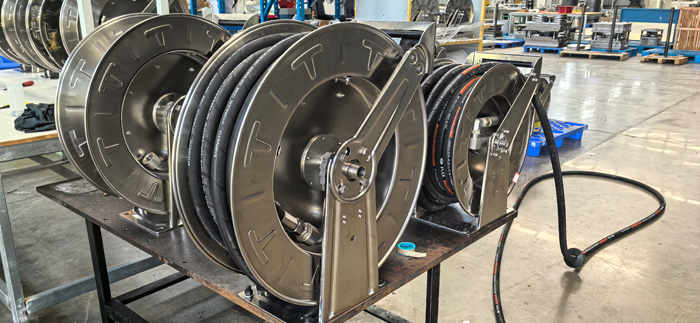What are the applications of hydraulic hose reels?
September 25, 2025 | Hose Reel Applications

Hydraulic hose reels are devices designed to store and protect hydraulic hoses while ensuring stable transmission of hydraulic fluids. Their core value lies in preventing tangled hoses and wear, enhancing operational safety and efficiency, and are widely used in scenarios requiring mobile hydraulic power. Below is a detailed overview of their specific applications and functional features across six core sectors: industrial manufacturing, construction engineering, transportation, agricultural machinery, emergency rescue, and mining operations.
I. Industrial Manufacturing
In industrial settings, hydraulic equipment (e.g., machine tools, robotic arms, presses) often requires flexible position adjustments. Hose reels enable “pull-as-needed, auto-retract-when-finished” operation, preventing hose entanglement or crushing by machinery.
Typical Application Scenarios:
Machine Tool Processing: Provides hydraulic power for mobile fixtures on CNC lathes and milling machines. The reel synchronously retracts/extends the hose as fixtures move, ensuring no hydraulic fluid leakage and stable pressure.
Automated production lines: Used for hydraulic drives in robotic arms and transfer mechanisms. Mounted on tracks or equipment brackets, the reel adapts to multi-directional arm movements, minimizing hose interference with production processes.
Heavy equipment maintenance: Tools like hydraulic wrenches and jacks in factories connect to fixed hydraulic stations via reels. This allows operators flexible maneuvering within a defined range without repeatedly relocating the hydraulic power source.
II. Construction Engineering Sector
In construction operations, hydraulic equipment (such as cranes, hydraulic breakers, and concrete pumps) often involves mobile work in complex environments (dust, debris). Reels protect hoses and enhance operational flexibility.
Typical Application Scenarios:
Hydraulic Cranes/Hoists: Reels mounted on the boom supply hydraulic power to telescoping arms and slewing mechanisms. They automatically retract and extend hoses as the boom moves, preventing sagging hoses from scraping against obstacles.
Hydraulic Breakers: Connected to excavator or loader hydraulic systems, reels store high-pressure breaker hoses, preventing damage from flying debris or entanglement in mechanical components during breaking operations.
Concrete Wet Sprayers: Used to convey hydraulic fluid driving the spray pump. The reel adapts to the swing range of the spray arm, ensuring stable fluid delivery and preventing hose kinks that could impair spraying efficiency.
III. Transportation Sector
Primarily serves vehicles requiring mobile hydraulic functions (e.g., specialty vehicles, commercial trucks), addressing the connection between “vehicle-mounted hydraulic equipment and stationary hydraulic power sources” while saving space.
Typical Application Scenarios:
Garbage Compactor Trucks: Reels mounted on the vehicle side connect the onboard hydraulic system to the garbage compactor. Retracting and extending the hose controls the compactor’s lifting and compression actions, preventing hose sway during vehicle movement.
Fire Trucks: Hydraulic rescue tools (e.g., hydraulic cutters, spreaders) on some fire trucks connect to onboard hydraulic pumps via reels. Firefighters can quickly pull out hoses for rescue operations without additional hydraulic piping.
Semi-Trailers / Dump Trucks: Provides hydraulic power for dump body lifting mechanisms and container locking devices. The reel stores the lifting hydraulic hose, preventing friction and wear against the ground during vehicle operation.
IV. Agricultural Machinery Sector
Agricultural machinery (such as tractors and harvesters) primarily operates in field environments, requiring resistance to mud and rough terrain. Hydraulic hose reels adapt to harsh conditions while facilitating seamless switching between multiple implements.
Typical Application Scenarios:
Tractor-mounted implements: Tractors connect rotary tillers and seeders to hydraulic drive components via hose reels. When switching implements, hoses need not be disconnected—simply retract the hose to move, enhancing operational efficiency.
Combine harvesters: Used to drive hydraulic mechanisms such as header elevation and conveyor chain speed adjustment. The reel retracts and extends hoses synchronously with header movement, preventing entanglement with crops or abrasion from field debris.
Plant Protection Machinery: When adjusting the spray angle of large sprayers’ hydraulic nozzles, the reel stores the hydraulic hose controlling the nozzle. This ensures flexible nozzle movement in the field without disrupting spray patterns.
V. Emergency Rescue Applications
Emergency scenarios (e.g., earthquake rescue, road repair) demand rapid equipment deployment. Hydraulic hose reels enable quick connection of hydraulic tools, saving critical rescue time.
Typical Applications:
Earthquake/Collapse Rescue: Hydraulic jacks and support columns on rescue vehicles connect to hydraulic power units via reels. Rescue personnel can rapidly extend hoses to erect supports or expand rescue spaces within debris without on-site pipe splicing.
Road Emergency Repairs: Hydraulic breakers and pavement cutters on emergency vehicles connect to onboard hydraulic systems via reels. This enables rapid pavement demolition and pothole repairs, minimizing traffic disruption.
Underwater Rescue: Hoses for certain underwater hydraulic tools (e.g., underwater cutters) require storage in waterproof reels. These reels feature watertight seals to prevent hydraulic fluid leakage underwater, supporting diver operations.
VI. Mining Operations
Mining environments are harsh (high dust, intense vibration, heavy loads), requiring hydraulic hose reels to feature high strength and wear resistance while meeting the high-pressure demands of heavy-duty mining equipment.
Typical Applications:
Mining Excavators / Loaders: Provide high-pressure hydraulic power for bucket lifting and boom extension/retraction. Reels accommodate large-diameter high-pressure hoses, withstanding intense mining vibrations to prevent hose joint loosening and leakage.
Mining Supports: In underground coal mines, the movement and elevation of hydraulic supports require long-distance hydraulic lines. Reels organize connecting hoses between supports, reducing cluttered routing in tunnels and minimizing collision risks with mine cars.
Crushing and Screening Equipment: Hydraulic crushers and vibrating screens in mining crushing stations connect to hydraulic power units via reels. This accommodates frequent equipment start-stops and adjustments while protecting hoses from impact by crushed materials.
Summary: Core Application Logic of Hydraulic Hose Reels
Their common application scenarios involve: mobile hydraulic power transmission + requirements for hose protection/operational efficiency. Reels in different fields are optimized for environmental needs (e.g., oil-resistant for industrial use, wear-resistant for mining, corrosion-resistant for agriculture, quick-connect for emergency use), but their core functions always revolve around “secure hose storage, stable hydraulic fluid transmission, and enhanced operational flexibility.”